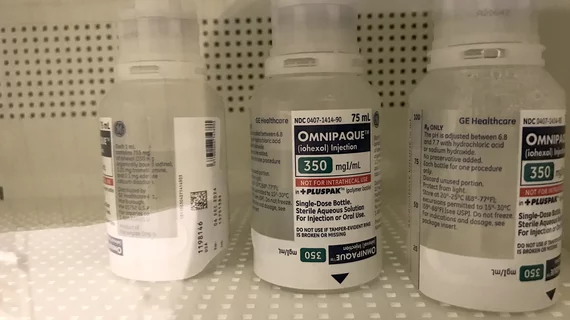Rethinking ICM storage could help imaging departments reduce waste by 59%
Optimizing the storage of iodinated contrast media (ICM) can lead to a significant reduction in contrast waste, according to new data published in the Journal of the American College of Radiology.[1]
“Within radiology, a CT department may stock only a single concentration and/or vial size of ICM to streamline inventory management, technologist workflow and protocol management, as well as to reduce risk of medication errors,” wrote first author Eric W. Pepin, MD, PhD, an assistant professor of radiology at UT Southwestern Medical Center in Dallas, and colleagues. “While drug pricing is not opaque and absolute costs of medications can vary widely, any waste comes at a cost.”
Pepin et al. examined the real-world use of ICM in a single U.S. safety net hospital that only stocks 100-mL ICM vials in its CT department, tracking contrast waste at that facility and estimating how different ICM utilization strategies may impact waste in the long run. Overall, the group focused on data from nearly 50,000 CT exams performed on more than 26,000 patients. The total amount of contrast media used was 4,168,335 mL, and the mean dose was 103 mL.
The group calculated that the hospital’s exclusive use of 100-mL ICM vials was associated with 1,006,165 mL of waste, or a mean waste of 26 mL per administration. Stocking optimally sized single-use ICM vials would have resulted in 436,515 mL of waste, or a mean waste of 11 mL per administration. Stocking multi-use ICM vials, meanwhile, would have resulted in 537,074 mL of waste, or a mean waste of 13 mL per administration. This translates to a 59% reduction in contrast waste for optimized single-use vials and a 50% reduction in contrast waste for multi-use vials.
“This investigation showed that there can be significant waste reduction and, in turn, cost savings if a more diversified approach to inventory management is implemented,” the authors wrote. “ICM waste directly translates to additional cost for the institution, as any ICM not administered to the patient has been paid for by the institution but not charged for.”
The researchers did note that making these inventory changes is not necessarily as easy as it sounds; stocking different ICM vials would require “operational adjustments and process changes” in the stockroom that would need to be planned out and implemented. In addition, the group wrote, one could argue that using different vial sizes could theoretically increase the risk of medication errors.
However, even with those concerns in mind, Pepin and colleagues highlighted the importance of reducing contrast waste whenever possible.
“Environmental concerns regarding ICM waste and costs associated with procuring iodine are increasingly coming to light,” the authors wrote. “As CT and ICM use rise, ICM is now found in drinking water sources and may not be effectively removed by existing purification techniques. Additionally, the cost of iodine extraction is high and sustainable practices in radiology are gaining more attention.”
Making these changes to storeroom management should also help healthcare providers protect themselves against the risk of ICM challenges such as the 2022 iohexol shortage caused by the COVID-19 pandemic.
Read the full study here.

